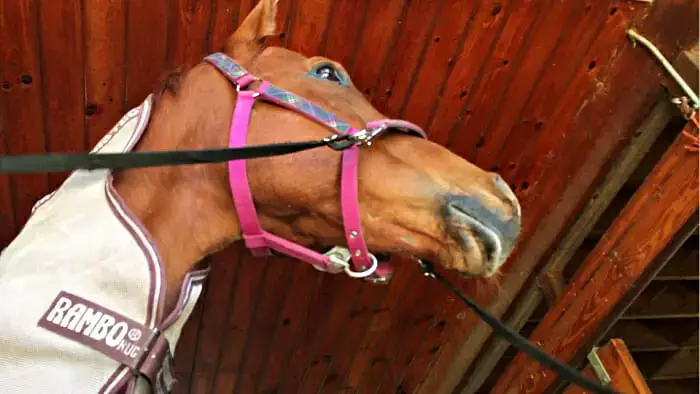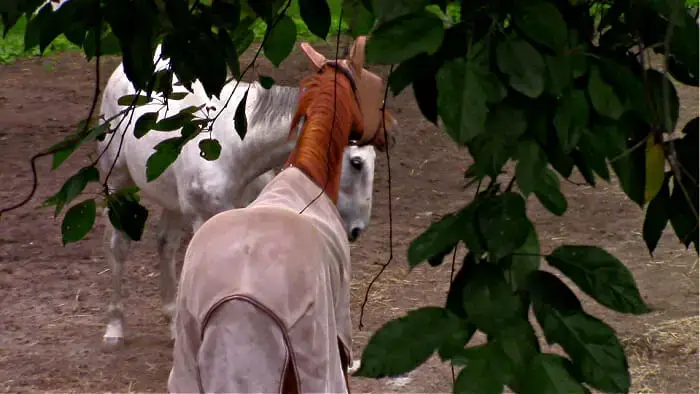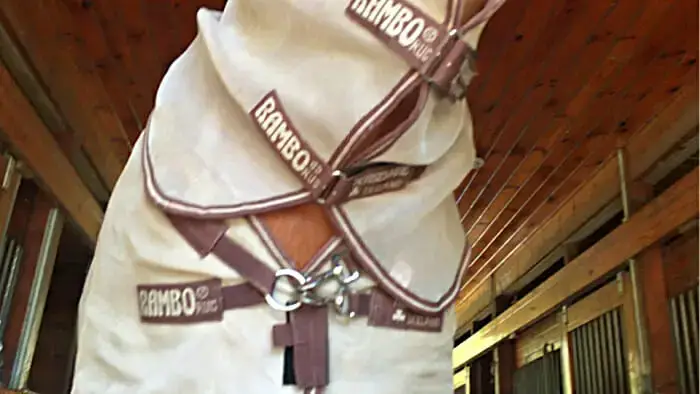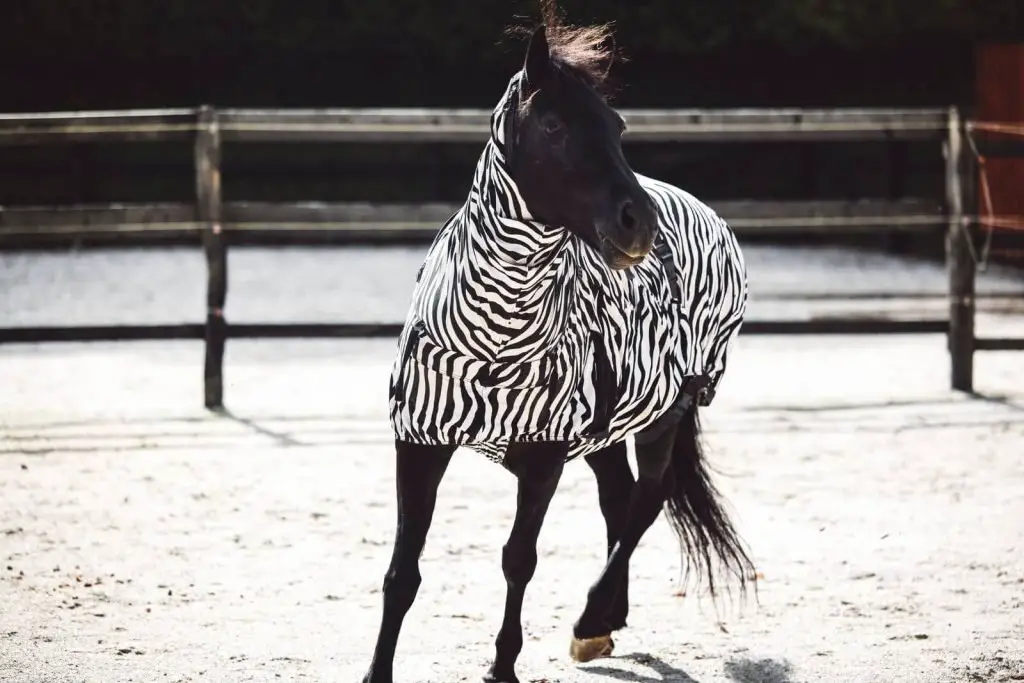Picture this – it’s a beautiful, sunny day, and you’re spending quality time with your horse when you notice they’re constantly swatting flies away. It’s frustrating, right? But do they really need a fly sheet, or can they manage without one?
As a horse owner, it’s essential to keep your horse comfortable and protected from pesky insects. Fly sheets can play a crucial role in this, but it’s not a one-size-fits-all solution.
In this helpful guide, we’ll explore factors to consider when deciding if your horse needs a fly sheet, alternatives and complementary products, and how to make the best decision for your horse’s well-being.
For more guidance, check out this related article: 7 Best Sheets for Horses: Plus Special Sized Fly Sheets
Table of Contents
Fly Sheets: A Quick Recap
Before we delve deeper, let’s quickly go over what fly sheets are and their purpose. Fly sheets are lightweight, breathable sheets designed to protect horses from biting insects and harmful UV rays.
If you’d like a more detailed look at the pros and cons of fly sheets, check out this article: Are Fly Sheets Good for Horses?

Assessing Your Horse’s Unique Needs
Every horse is unique, with different levels of sensitivity, breed characteristics, and environmental factors that can impact their need for a fly sheet.
Let’s explore some of the key factors to consider when evaluating whether your horse needs extra protection from biting insects.
Identifying Your Horse’s Insect Sensitivity
Just like us humans, horses have different levels of sensitivity to insects. Some may barely react to fly bites, while others could become agitated or develop skin irritations.
Keep an eye on your horse’s behavior, especially during peak insect season, to understand their level of sensitivity.
You may notice:
- Excessive tail swishing or head shaking
- Skin reactions, such as hives or bumps
- Restlessness or signs of stress
- Pacing the fence line, attempting to escape from the flies
- Galloping or bolting away from the insects
Taking note of these reactions will help you determine if your horse needs extra protection, like a fly sheet, to keep them comfortable.
Evaluating Local Climate and Fly Populations
Where you live plays a significant role in whether your horse needs a fly sheet. In areas with warm, humid climates, fly populations tend to be higher.
On the other hand, cooler regions may have fewer flies, making a fly sheet less necessary.
Keep track of seasonal changes and consider any geographic factors that could affect the local insect population.
If your new to the area you might want to:
- Consult local weather data for trends in temperature and humidity
- Pay attention to regional insect forecasts, if available
- Speak with other horse owners in your area about their experiences with flies and other pests
Gathering this information will help you understand the likelihood of your horse encountering a high fly population and whether a fly sheet is a worthwhile investment.
Breed Considerations
Certain horse breeds may be more sensitive to insects due to differences in coat types and thicknesses. Research your horse’s breed to understand any specific sensitivities or predispositions to insect bites.
For example:
- Thinner-skinned breeds, such as Thoroughbreds and Arabians, may be more susceptible to fly bites and skin irritations
- Horses with lighter-colored coats might experience more sunburn, making a UV-protective fly sheet beneficial
- Thicker-skinned breeds and those with denser hair typically tolerate the flies better, potentially reducing the need for a fly sheet
By researching your horse’s breed characteristics and talking to other owners or professionals familiar with that breed, you’ll gain valuable insight into whether a fly sheet is the right choice for your horse.

When Your Horse Doesn’t Need a Fly Sheet
Before diving into the alternatives and complementary products to fly sheets, let’s explore some situations where your horse might not actually need a fly sheet.
Knowing when a fly sheet isn’t necessary can save you time and money while still ensuring your horse’s comfort and well-being.
Cooler Climates with Fewer Insects
If you’re fortunate enough to live in an area with cooler temperatures and fewer insects buzzing around, your horse might be perfectly comfortable without a fly sheet. In these environments, flies and other biting insects may be less prevalent, which means your horse might not need that extra layer of protection.
However, it’s still essential to monitor your horse’s comfort level and insect exposure, as conditions can change from season to season.
Horses with Minimal Insect Sensitivity
Just like people, horses have individual sensitivities to insects. Some horses seem to take the presence of flies in stride, showing little to no reaction to their bites.
If your horse is one of these tough cookies, they might not need a fly sheet. But remember, always keep an eye on your horse’s skin and behavior to ensure they remain comfortable and free from irritation.
Temporary Protection Alternatives
Sometimes, your horse may not need a full fly sheet but could benefit from temporary protection against insects. This brief overview of temporary alternatives will be followed by a more detailed section about various alternatives and complementary products to fly sheets.
Keep in mind that these options can be particularly useful during travel, events, or when your horse’s living conditions change temporarily:
- Fly repellent sprays: Provide short-term protection against insects by applying a horse-safe spray directly to your horse’s coat.
- Fly masks and leg wraps: Offer targeted protection for sensitive areas like the eyes, ears, and legs, and can be easily put on and removed as needed.
- Portable screened shelters: Create a temporary fly-free zone for your horse during travels or events by setting up a portable shelter with screens.
Stay tuned for a comprehensive discussion on alternatives and complementary products to fly sheets in the next section!

Alternatives and Complementary Products to Fly Sheets
Don’t worry if you’re still unsure about whether a fly sheet is the right choice for your horse. There are plenty of other options out there to protect your equine friend from pesky insects.
Let’s explore some of these alternatives and complementary products in more detail!
Fly Repellent Sprays: Keeping Bugs at Bay
Fly sprays can be a fantastic alternative or addition to fly sheets. They’re applied directly to your horse’s coat, creating a barrier against biting insects. Remember to choose a spray that’s safe for your horse and follow the application instructions carefully. It’s a good idea to reapply as needed, especially after your horse sweats or gets wet.
Fly Masks and Leg Wraps: Targeted Protection for Sensitive Areas
Fly masks and leg wraps offer focused protection for your horse’s sensitive areas like the eyes, ears, and legs. These products can be used alone or in combination with a fly sheet for maximum protection. Look for masks and wraps that are comfortable, well-ventilated, and easy to clean.
Natural Insect Control Methods: Harnessing the Power of Nature
Instead of relying solely on fly sheets, you can use various natural methods to keep insect populations under control:
- Introducing predator insects: Welcome insects like ladybugs and praying mantises into your horse’s environment. These helpful critters prey on pests like flies, helping to keep their numbers in check.
- Implementing proper sanitation practices: A clean living area is essential for discouraging insect breeding. Regularly clean your horse’s stall or paddock, remove manure, and ensure proper drainage to keep insects at bay.
- Creating a fly-free environment: Design your horse’s living space to minimize fly-friendly areas, such as stagnant water or damp bedding. Make sure to replace wet bedding promptly and maintain clean water sources.
- Using chickens to reduce fly populations: Chickens are amazing at keeping insects under control. Having them around your horse’s living area can help reduce the fly population while providing some entertainment for your horse!
- Employing bug traps and fly tape: Install bug traps and fly tape around your horse’s environment to catch and control flies. Remember to replace the traps and tape regularly to maintain their effectiveness.
- Managing water sources to minimize breeding grounds: Ensure water sources are clean and free of standing water to prevent flies from breeding. Clean water troughs and buckets regularly, and check for any hidden pools of water in your horse’s living area.
- Turning horses out at night to avoid daytime biting flies: Since biting flies are most active during the day, consider turning your horse out at night to minimize their exposure to these annoying pests.
Shelters with Screens: A Safe Haven for Your Horse
Installing screens in your horse’s shelter can help keep flies out, providing a comfortable, fly-free zone for your horse to relax. Choose screens with small mesh sizes to prevent even the tiniest insects from entering while still allowing for proper ventilation.
Feed-Through Fly Control: Disrupting the Fly Life Cycle
Feed-through fly control products are added to your horse’s food and work by making their manure unattractive to flies, thus reducing breeding grounds. Be sure to choose a product that’s safe and suitable for your horse, and follow the recommended feeding guidelines.
Keep in mind that these products may take a few weeks to become fully effective, so start using them before fly season begins.

Making the Right Choice for Your Horse
By considering your horse’s unique needs and exploring alternatives, you can make an informed decision about whether a fly sheet is necessary for your horse’s comfort and well-being.
We’ve discussed factors like insect sensitivity, local climate, and breed, and looked at various alternatives and complementary products to fly sheets. Consulting professionals and balancing the pros and cons can help you make the best decision for your horse.
Observe your horse closely during insect season, research their breed’s specific sensitivities, and explore alternative options.
Don’t hesitate to seek advice from professionals like veterinarians or experienced equestrians for guidance.
| Key Takeaways |
|---|
| 1. Observe your horse’s insect sensitivity to understand their need for a fly sheet. |
| 2. Local climate and fly populations play a significant role in determining fly sheet necessity. |
| 3. Breed-specific sensitivities may affect your horse’s need for a fly sheet. |
| 4. In some cases, horses may not need a fly sheet due to cooler climates or minimal sensitivity. |
| 5. Alternatives to fly sheets include fly sprays, fly masks, leg wraps, and natural control methods. |
| 6. Screened shelters and feed-through fly control products can help minimize flies. |
| 7. Weigh the pros and cons to make an informed decision for your horse. |
| 8. Consult professionals like veterinarians or experienced equestrians for guidance. |
What alternative fly control methods have you found most effective in keeping your horse comfortable during insect season? Share your experiences and tips with fellow horse owners!
Cheers, Kacey
P.S. Did you like this article? Gallop over to:

